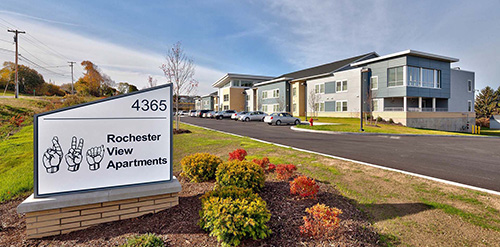Social and Community Equity Through Design

Published previously in “Architecture New York State”, the magazine of the NYS American Institute of Architects
Our most rewarding and accomplished projects are those that involve the community defining the design goals. Using spaces to enrich people’s lives and support strong communities is the essence of what we do as designers. Our success depends on how well we understand the priorities of the residents and how this knowledge is placed into the larger context. Working closely with a community forms the core of a design process that looks different on every project. This allows the voice of individual designers and individual communities to shape each project in a unique way. Rochester View Apartments (RVA) and Wedgepoint Apartments (Wedgepoint) are two projects, in two very different settings, that used this integrated process successfully.
RVA is a 61-unit affordable housing community in suburban Rochester designed to support the needs of the deaf and hard-of-hearing population. With Rochester having the nation’s largest per capita population of deaf and hard-of-hearing RVA celebrates deaf culture by providing an environment of community, safety, and opportunity that did not previously exist. We worked with the building owner to bring a team of stakeholders together early and often, including representatives from the National Center for Deaf Health Research, the National Technical Institute for the Deaf, Rochester School for the Deaf, and several interested members of the local Deaf community, to learn about the challenges involved in living without hearing. Our biggest takeaway from this feedback was the need to create a space for the residents that was not only safe, but provided them an opportunity to live independently in an environment where they could freely communicate with their neighbors, options many people take for granted, but can be challenging to find for the deaf community.
Community involvement led directly to specific aesthetic and planning decisions. Located along a busy arterial, the building presents a dynamic face to a world racing by. The front elevation’s playful facade shifts in color and material, evoking the graceful movements of American Sign Language (ASL). The roofline is just as dynamic, with a central volume leaping above the building to provide a strong visual signifier of the main entrance. Within this volume, the lobby and community room are filled with soft daylight. The ample lighting and bright color pallet serve to enhance ASL communication. Our community design process also led to some innovative design solutions that we may not have otherwise explored, such as the need for generous lighting to support visual communication with ASL and the importance of direct line-of-site in planning.
Communal and support spaces are connected spatially or visually. Computer lounges are oriented so users face obliquely to the open walkway. Apartment plans have an open design, with clear site lines from the kitchen to the bedroom and bathroom doors, the entrance and the living room. Technology solutions were also leveraged, equipping every apartment with a system of strobe lights to signal the fire and CO alarms, the apartment doorbell, and the video phone, which is connected to the vestibule intercom. Wi-Fi is provided throughout the building.
Wedgepoint, a 60-unit affordable housing project in the South Wedge neighborhood of Rochester N.Y., is located on an unusually shaped parcel at the edge of an eclectic neighborhood that abuts downtown. This site had been sitting empty since 2002 when a former run-down motor lodge was demolished. It is bracketed by busy streets with a mix of social services, thrift stores, restaurants, and residences; it has great access to transit and a phenomenal view of the downtown skyline. Designed with social equity in mind, Wedgepoint achieves a healthy density through maximizing social, economic and cultural interactions.
The South Wedge is a thriving neighborhood where residents feel connected with each other and are committed to making it a better to place to live, work, socialize, and raise a family. With this in mind, we engaged the developer, the Business Association of the South Wedge Area (BASWA), and the South Wedge Planning Committee (SWPC) in a series of working sessions to discuss the design intent and to lay the framework for an inclusive design process. What was iterated across the constituents was a deep need for this building to integrate with the surrounding neighborhood and not be isolated and fenced in. The ground level has 5,600sf of retail and commercial space, which helps tremendously in allowing it to be open and inviting. Large commercial sized windows line the facades, providing high visibility from the street and natural light to the interiors.
In order to give the building a residential, rather than institutional look, it was designed to visually break into two buildings. The entry is a two-story exterior space with a bridge above connecting the 3rd and 4th levels. The bridge creates a ‘breezeway’ experience for the lower levels, which passes by the entry and terminates at the courtyard space. Walk up units on the first floor line the courtyard, providing security for the children on the playground and offering those units a pleasant view. On the 4th level, an outdoor terrace with large planter boxes for a resident-based food gardening program offers a strong visual connection to the courtyard below and grander views of the South Wedge neighborhood in the distance.
Both projects also focused on energy efficiency, utilizing LED lighting, energy efficient appliances and HVAC systems, a tightly sealed building envelope and, at RVA, a roof mounted photovoltaic system to reduce the building’s energy usage footprint. Beyond simply “doing the right thing,” this focus on sustainability helps reduce the living expenses for residents.
These two projects, one urban and one suburban, intended for two very different communities, used one core principle to find success. Each project team built their design process on a foundation of community involvement. The resulting building forms are completely different, and they are each successful in serving their communities. Residents at RVA report feeling less isolated and disconnected then in previous settings; they have been able to build new friendships, socialize and truly be part of a community. Wedgepoint provides strong connections to the surrounding neighborhood, forming an anchor for this edge of the South Wedge. In each project, strong community interaction led directly to a building that is an asset to its community and its residents.
